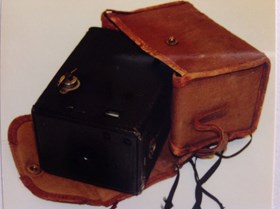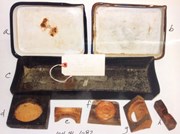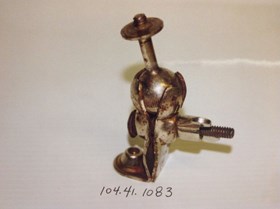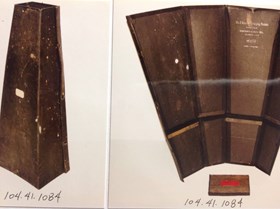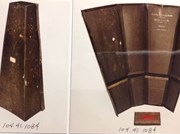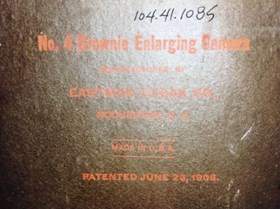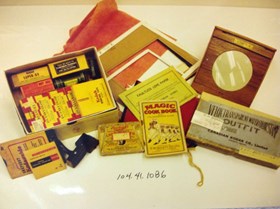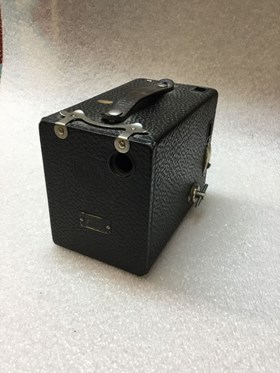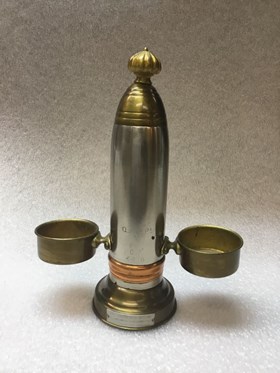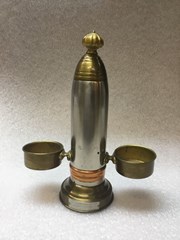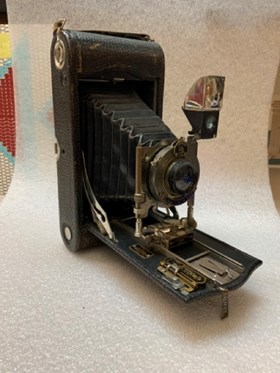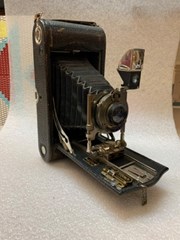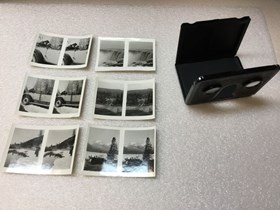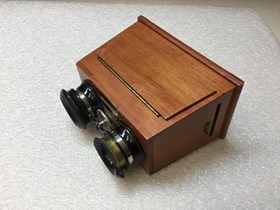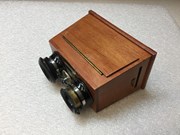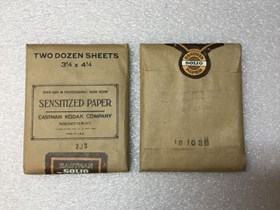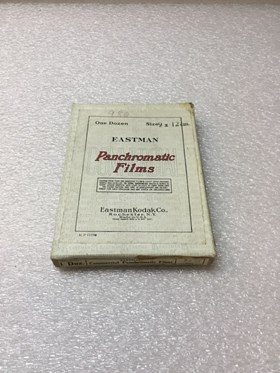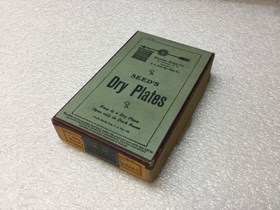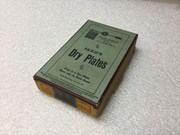Narrow Results By
- Date
- 1900 – 1920
- Material
- paper; metal; skin; glass
- Catalogue Number
- 104.41.1081
- Description
- One Kodak No. 2 Brownie box camera (a) in brown canvas case (b). Inside back of camera reads: “No. 2 Brownie camera. Model C. U.S. Patents Sept. 25, 1894; April 11, 1899; Jan. 21, 1902; April 14, 1903. Made by Eastman Kodak Co., Rochester, N.Y., U.S.A.” Handwritten inside of canvas case reads: “Dor…
1 image
- Title
- Box Camera
- Date
- 1900 – 1920
- Material
- paper; metal; skin; glass
- Dimensions
- 11.0 x 8.0 x 14.0 cm
- Description
- One Kodak No. 2 Brownie box camera (a) in brown canvas case (b). Inside back of camera reads: “No. 2 Brownie camera. Model C. U.S. Patents Sept. 25, 1894; April 11, 1899; Jan. 21, 1902; April 14, 1903. Made by Eastman Kodak Co., Rochester, N.Y., U.S.A.” Handwritten inside of canvas case reads: “Doris Earl Gammon. 220 Bow Ave. Banff Alberta Canada. “ Old address crossed out reads: “16 Old Compton St. London W1”.
- Subject
- photography
- Doris Gammon
- Credit
- Gift of Doris Gammon, Banff, 2000
- Catalogue Number
- 104.41.1081
Images
This material is presented as originally created; it may contain outdated cultural descriptions and
potentially offensive content.
Read more.
Print-Processing Tray
https://archives.whyte.org/en/permalink/artifact104.41.1082%20a-h
- Date
- 1910 – 1950
- Material
- metal; enamel; wood; plastic;
- Catalogue Number
- 104.41.1082 a-h
- Description
- Three developing trays, a) & b) are white rectangular metal with blue trim. Tray c) is long narrow black rectangular plastic(?). Tray b) has manufacturer’s stamp on side: “CANADIAN KODAK CO. LTD. 5 X 7” & “AUSTRIA” on the bottom. Five handmade wooden clock timer rests (d-h) for darkroom use. Typewr…
1 image
- Title
- Print-Processing Tray
- Date
- 1910 – 1950
- Material
- metal; enamel; wood; plastic;
- Description
- Three developing trays, a) & b) are white rectangular metal with blue trim. Tray c) is long narrow black rectangular plastic(?). Tray b) has manufacturer’s stamp on side: “CANADIAN KODAK CO. LTD. 5 X 7” & “AUSTRIA” on the bottom. Five handmade wooden clock timer rests (d-h) for darkroom use. Typewritten paper tag by Bert Riggall’s daughter reads: “A sample of Dad-Bert’s film developing trays and clock-timer ‘rests’. The black tray was for panorama films and prints.”
- Credit
- Gift of Dale Burton, Surrey, 1999
- Catalogue Number
- 104.41.1082 a-h
Images
This material is presented as originally created; it may contain outdated cultural descriptions and
potentially offensive content.
Read more.
- Date
- 1910 – 1950
- Material
- metal
- Catalogue Number
- 104.41.1083
- Description
- Metal ball/swivel tripod top with manufacturer’s stamp on back: “EKC” (Eastman Kodak Co.).
1 image
- Title
- Tripod
- Date
- 1910 – 1950
- Material
- metal
- Dimensions
- 9.0 x 5.5 cm
- Description
- Metal ball/swivel tripod top with manufacturer’s stamp on back: “EKC” (Eastman Kodak Co.).
- Credit
- Gift of Dale Burton, Surrey, 1999
- Catalogue Number
- 104.41.1083
Images
This material is presented as originally created; it may contain outdated cultural descriptions and
potentially offensive content.
Read more.
Daylight Enlarger
https://archives.whyte.org/en/permalink/artifact104.41.1084
- Date
- 1908 – 1920
- Material
- fibre; paper; metal; wood
- Catalogue Number
- 104.41.1084
- Description
- Collapsable daylight enlarger, four-sided with snaps along edge. Can be dismantled and stored flat. Rectangular black wooden piece hold lens and is suspended inside enlarger. Enlarger constructed of cardboard covered with coated black fabric. Inside enlarger stamped: “No. 2 Brownie Enlarging Camera…
1 image
- Title
- Daylight Enlarger
- Date
- 1908 – 1920
- Material
- fibre; paper; metal; wood
- Dimensions
- 49.0 x 18.0 cm
- Description
- Collapsable daylight enlarger, four-sided with snaps along edge. Can be dismantled and stored flat. Rectangular black wooden piece hold lens and is suspended inside enlarger. Enlarger constructed of cardboard covered with coated black fabric. Inside enlarger stamped: “No. 2 Brownie Enlarging Camera. MANUFACTURED BY EASTMAN KODAK CO., ROCHESTER, N.Y. MADE IN U.S.A. PATENTS APPLIED FOR.”
- Credit
- Gift of Dale Burton, Surrey, 1999
- Catalogue Number
- 104.41.1084
Images
This material is presented as originally created; it may contain outdated cultural descriptions and
potentially offensive content.
Read more.
Daylight Enlarger
https://archives.whyte.org/en/permalink/artifact104.41.1085%20a-c
- Date
- 1908 – 1920
- Material
- fibre; paper; metal; wood
- Catalogue Number
- 104.41.1085 a-c
- Description
- Collapsable daylight enlarger (a), four-sided with snaps along edge. Can be dismantled and stored flat. Rectangular black wooden piece with hole in centre for lens (b) is suspended inside enlarger. Easel (c) is made of wooden frame with cardboard back covered with black coated fabric. Enlarger cons…
1 image
- Title
- Daylight Enlarger
- Date
- 1908 – 1920
- Material
- fibre; paper; metal; wood
- Dimensions
- 46.0 x 25.0 cm
- Description
- Collapsable daylight enlarger (a), four-sided with snaps along edge. Can be dismantled and stored flat. Rectangular black wooden piece with hole in centre for lens (b) is suspended inside enlarger. Easel (c) is made of wooden frame with cardboard back covered with black coated fabric. Enlarger constructed of cardboard covered with coated black fabric. Inside enlarger stamped: “No. 4 Brownie Enlarging Camera. MANUFACTURED BY EASTMAN KODAK CO., ROCHESTER, N.Y. MADE IN U.S.A. PATENTED JUNE 23, 1908.”
- Credit
- Gift of Dale Burton, Surrey, 1999
- Catalogue Number
- 104.41.1085 a-c
Images
This material is presented as originally created; it may contain outdated cultural descriptions and
potentially offensive content.
Read more.
Photographic Accessories
https://archives.whyte.org/en/permalink/artifact104.41.1086
- Date
- 1910 – 1950
- Material
- paper; wood; metal; rubber; fibre; glass; hair
- Catalogue Number
- 104.41.1086
- Description
- Miscellaneous photographic accessories including Velox transparent watercolour stamp outfit, film, snapshot Kodaguide, lens paper, spotting brush and colours, two rubber stamps: “F.H. RIGGALL, TWIN BUTTE, ALTA.” & “F.H. RIGGALL, GUIDE AND OUTFITTER”, DUFAYCOLOR transparency viewer, etc.
1 image
- Title
- Photographic Accessories
- Date
- 1910 – 1950
- Material
- paper; wood; metal; rubber; fibre; glass; hair
- Description
- Miscellaneous photographic accessories including Velox transparent watercolour stamp outfit, film, snapshot Kodaguide, lens paper, spotting brush and colours, two rubber stamps: “F.H. RIGGALL, TWIN BUTTE, ALTA.” & “F.H. RIGGALL, GUIDE AND OUTFITTER”, DUFAYCOLOR transparency viewer, etc.
- Credit
- Gift of Dale Burton, Surrey, 1999
- Catalogue Number
- 104.41.1086
Images
This material is presented as originally created; it may contain outdated cultural descriptions and
potentially offensive content.
Read more.
Brownie Camera
https://archives.whyte.org/en/permalink/artifact104.41.0176
- Date
- 1901 – 1935
- Material
- leather; metal; cardboard; glass
- Catalogue Number
- 104.41.0176
- Description
- Dark brown/black Kodak No. 2 Brownie camera with a leather strap that has “BROWNIE’ stamped on it on the top, two viewfinders [one on top, one on the right side], a back panel that hinges open to access the film compartment [this compartment is metal and removable], a thin metal rod that rotates th…
1 image
- Title
- Brownie Camera
- Date
- 1901 – 1935
- Material
- leather; metal; cardboard; glass
- Dimensions
- 11.3 x 9.4 x 14.4 cm
- Description
- Dark brown/black Kodak No. 2 Brownie camera with a leather strap that has “BROWNIE’ stamped on it on the top, two viewfinders [one on top, one on the right side], a back panel that hinges open to access the film compartment [this compartment is metal and removable], a thin metal rod that rotates the film inside, and the lever that triggers the lens. Attached to the back is a small rectangular metal plaque with the manufacturer’s details and above it is an embossed stamp that identifies this camera as being “No. 120.”
- Credit
- Gift of Eddie Hunter, Banff, 1995
- Catalogue Number
- 104.41.0176
Images
This material is presented as originally created; it may contain outdated cultural descriptions and
potentially offensive content.
Read more.
- Date
- 1915 – 1916
- Material
- metal;
- Catalogue Number
- 102.05.0124
- Description
- Metal candle holder made from old artillery ammunition consisting of a central large silver bullet capped with a gold-coloured cap and decorative bauble on top and a copper band around the base, two gold-coloured candle holders on either side of an inscription on the bullet that reads “Q. F. 18PR V…
1 image
- Title
- Candle Holder
- Date
- 1915 – 1916
- Material
- metal;
- Dimensions
- 19.4 x 7.0 x 15.5 cm
- Description
- Metal candle holder made from old artillery ammunition consisting of a central large silver bullet capped with a gold-coloured cap and decorative bauble on top and a copper band around the base, two gold-coloured candle holders on either side of an inscription on the bullet that reads “Q. F. 18PR V F. C. F. 4-4-16,” and a wider gold-coloured base that has a small silver plaque that has the inscription “THE SHRAPNEL STAND COLONIAL FIXTURES LTD. REGISTERED 1915.”Souvenirs made from spent artillery shells were common during World War I. Objects such as boxes/cases, candle holders, simple toys, plates, cups, and more were prevalent due to the simple modifications to the ammunition that were needed.
- Credit
- Gift of Robert Crosby Family, Banff, 1998
- Catalogue Number
- 102.05.0124
Images
This material is presented as originally created; it may contain outdated cultural descriptions and
potentially offensive content.
Read more.
- Date
- 1914 – 1917
- Material
- leather; metal; glass;
- Catalogue Number
- 104.41.0193
- Description
- Black hard-sided leather No. 3-A Autographic Kodak Model C folding camera. The front panel is released by pressing a small round metal button on the narrow bottom edge [the bottom of the camera is noted by the presence of a threaded hole where a tripod could be mounted] and has a small rectangular …
1 image
- Title
- Kodak Camera
- Date
- 1914 – 1917
- Material
- leather; metal; glass;
- Dimensions
- 5.0 x 12.0 x 25.0 cm
- Description
- Black hard-sided leather No. 3-A Autographic Kodak Model C folding camera. The front panel is released by pressing a small round metal button on the narrow bottom edge [the bottom of the camera is noted by the presence of a threaded hole where a tripod could be mounted] and has a small rectangular metal foot with “Kodak” engraved in decorative writing that keeps the camera propped up. The lens mechanism slides out on tracks with soft black leather bellows behind it and a viewfinder with a pop-up cover attached to the top right-hand corner. The back panel of the camera pops off by pressing two metal clasps on both short sides and can house a roll of film. When the camera is open, on the top is a leather strap with a faded “Kodak” embossed on it.
- Subject
- Crosby family
- Abegweit
- cameras
- photography
- Kodak;
- Credit
- Gift of Robert Crosby Family, Banff, 1998
- Catalogue Number
- 104.41.0193
Images
This material is presented as originally created; it may contain outdated cultural descriptions and
potentially offensive content.
Read more.
- Date
- 1900 – 1920
- Material
- metal; paper; glass;
- Catalogue Number
- 105.05.0036
- Description
- Black metal folding stereoscope with six paper photographs. The stereoscope has a solid metal base and a solid metal side that has a built-in dual frame to house the photographs and that folds up away from the base - the other side that folds away from the base has two small round plain glass lense…
1 image
- Title
- Stereoscope
- Date
- 1900 – 1920
- Material
- metal; paper; glass;
- Dimensions
- 9.8 x 9.0 x 12.5 cm
- Description
- Black metal folding stereoscope with six paper photographs. The stereoscope has a solid metal base and a solid metal side that has a built-in dual frame to house the photographs and that folds up away from the base - the other side that folds away from the base has two small round plain glass lenses with a rounded hole between them for the nose. The photographs depict Niagara Falls, a suspension bridge, and scenic winter photos from around Banff National Park that feature people in an open-top automobile.
- Subject
- Crosby family
- Abegweit
- photography
- pictures
- souvenirs
- waterfalls
- automobiles
- Banff National Park
- bridges;
- Credit
- Gift of Robert Crosby Family, Banff, 1998
- Catalogue Number
- 105.05.0036
Images
This material is presented as originally created; it may contain outdated cultural descriptions and
potentially offensive content.
Read more.
- Date
- 1910 – 1915
- Material
- wood; glass; plastic; metal;
- Catalogue Number
- 105.05.0037
- Description
- Wooden handheld stereoscope with black plastic and gold metal lenses mounted on one side that also has a thin diamond-shaped metal plaque with the manufacturer details. The lenses resemble opera glasses and are set slightly away from the box with a silver metal dial in the middle to adjust the leng…
1 image
- Title
- Stereoscope
- Date
- 1910 – 1915
- Material
- wood; glass; plastic; metal;
- Dimensions
- 7.6 x 11.5 x 13.2 cm
- Description
- Wooden handheld stereoscope with black plastic and gold metal lenses mounted on one side that also has a thin diamond-shaped metal plaque with the manufacturer details. The lenses resemble opera glasses and are set slightly away from the box with a silver metal dial in the middle to adjust the length - both lenses have black plastic mounts that rest against the face that can twist off. The top of the stereoscope has a panel on a gold metal hinge that can fold up with a mounted mirror on the inside. The right-hand side has a small slit vertically near the frosted glass window where the image can be inserted - there is a small metal tab mounted beside the slit to hold the image inside the box. The main window of the stereoscope consists of a frosted glass window to allow diffused light into the box - the panel containing the window can fold away from the box on a gold metal hinge so that the interior can be accessed.
- Subject
- Crosby family
- Abegweit
- photography
- souvenirs
- Credit
- Gift of Robert Crosby Family, Banff, 1998
- Catalogue Number
- 105.05.0037
Images
This material is presented as originally created; it may contain outdated cultural descriptions and
potentially offensive content.
Read more.
- Date
- 1905 – 1924
- Material
- paper;
- Catalogue Number
- 104.41.0200 a,b
- Description
- Two packages of 3 1/4 x 4 1/4 Kodak Sensitized Paper, also known as Solio Paper, in brown paper wrapping - unopened. Details of the contents stamped on the front in black ink, and the packages are held closed with a brown, orange, and white “EASTMAN SOLIO PAPER” sticker that wraps over the bottom e…
1 image
- Title
- Photo Paper
- Date
- 1905 – 1924
- Material
- paper;
- Dimensions
- 0.9 x 9.4 x 11.8 cm
- Description
- Two packages of 3 1/4 x 4 1/4 Kodak Sensitized Paper, also known as Solio Paper, in brown paper wrapping - unopened. Details of the contents stamped on the front in black ink, and the packages are held closed with a brown, orange, and white “EASTMAN SOLIO PAPER” sticker that wraps over the bottom edge from front to back. Faded stamps on the backs are mostly illegible, but the expiration date of “MAY 15 1924” is visible.
- Credit
- Gift of Robert Crosby Family, Banff, 1998
- Catalogue Number
- 104.41.0200 a,b
Images
This material is presented as originally created; it may contain outdated cultural descriptions and
potentially offensive content.
Read more.
Panchromatic Film
https://archives.whyte.org/en/permalink/artifact104.41.0201
- Date
- 1906 – 1923
- Material
- cardboard; paper;
- Catalogue Number
- 104.41.0201
- Description
- One box of a dozen 9x12cm Eastman Commercial Panchromatic Films - unopened. The box has a large paper label on the lid containing the manufacturer and development details throughout, as well as “9.80” written in pencil at the top. The edges and bottom of the box are sealed with brown paper adhesive…
1 image
- Title
- Panchromatic Film
- Date
- 1906 – 1923
- Material
- cardboard; paper;
- Dimensions
- 1.5 x 10.0 x 13.7 cm
- Description
- One box of a dozen 9x12cm Eastman Commercial Panchromatic Films - unopened. The box has a large paper label on the lid containing the manufacturer and development details throughout, as well as “9.80” written in pencil at the top. The edges and bottom of the box are sealed with brown paper adhesive tape, the right-hand side is stamped with “DEVELOP BEFORE APRIL 1923.”Panchromatic film is a kind of black-and-white emulsion that is sensitive to all visible light wavelengths and creates realistic photographs - it could also be used successfully for colour and black-and-white motion pictures as early as 1913. One downside to panchromatic film was that it had to be developed in complete darkness as it was sensitive to the red lights standard in many darkrooms.
- Credit
- Gift of Robert Crosby Family, Banff, 1998
- Catalogue Number
- 104.41.0201
Images
This material is presented as originally created; it may contain outdated cultural descriptions and
potentially offensive content.
Read more.
- Date
- 1908 – 1908
- Material
- cardboard;
- Catalogue Number
- 104.41.0202
- Description
- Empty cardboard box of Kokak Solio Toning and Fixing Powder cartridges with manufacturer and product details printed throughout the white box in red and black. Toning powders were chemical compounds designed to react with the emulsion layers of positive photographs that altered the tone (or colour)…
1 image
- Title
- Solio Powder
- Date
- 1908 – 1908
- Material
- cardboard;
- Dimensions
- 2.2 x 10.2 x 8.8 cm
- Description
- Empty cardboard box of Kokak Solio Toning and Fixing Powder cartridges with manufacturer and product details printed throughout the white box in red and black. Toning powders were chemical compounds designed to react with the emulsion layers of positive photographs that altered the tone (or colour) of the image, usually turning a standard black-and-white image into warmer shades of red, brown, and/or purple - sepia is a very common tone. Additionally, toning powders could be combined with a fixing agent that stabilized the emulsion layer to prevent it breaking down or fading, flaking off, or otherwise ruining the image as it set.
- Subject
- Crosby family
- Abegweit
- photography
- photographic equipment
- chemicals
- photograph development
- Kodak;
- Credit
- Gift of Robert Crosby Family, Banff, 1998
- Catalogue Number
- 104.41.0202
Images
This material is presented as originally created; it may contain outdated cultural descriptions and
potentially offensive content.
Read more.
Exposure Plates
https://archives.whyte.org/en/permalink/artifact104.41.0207
- Date
- 1902 – 1920
- Material
- cardboard; paper; glass;
- Catalogue Number
- 104.41.0207
- Description
- Box of one dozen 3 1/4 x 5 1/2 glass Seed’s Dry Plates with cut paper adhesive tape around the edges and bottom and manufacturer details printed on a pale green background throughout the lid. These dry plates were invented by M.A. Seed in 1879 and became very popular with photographers as the plate…
1 image
- Title
- Exposure Plates
- Date
- 1902 – 1920
- Material
- cardboard; paper; glass;
- Dimensions
- 3.0 x 9.3 x 15.0 cm
- Description
- Box of one dozen 3 1/4 x 5 1/2 glass Seed’s Dry Plates with cut paper adhesive tape around the edges and bottom and manufacturer details printed on a pale green background throughout the lid. These dry plates were invented by M.A. Seed in 1879 and became very popular with photographers as the plates came pre-prepared with the emulsion layer already applied - prior to “dry” plates, photographers would need portable dark rooms in which they would create their liquid emulsions prior to taking a photograph [known as “wet” plates]. Seed’s dry plates still required they be opened in a dark room, but this could be accomplished in the field by placing a dark sheet over the camera while loading and unloading the plates. In 1902, Eastman Kodak purchased Seed’s company [Seed Dry Plate Co.], but continued to capitalize on his name due to its reputation among consumers.
- Credit
- Gift of Robert Crosby Family, Banff, 1998
- Catalogue Number
- 104.41.0207
Images
This material is presented as originally created; it may contain outdated cultural descriptions and
potentially offensive content.
Read more.
Folding Camera
https://archives.whyte.org/en/permalink/artifact104.41.0237
- Date
- ca. 1922 – 1932
- Material
- metal; leather; glass
- Catalogue Number
- 104.41.0237
- Description
- Black hard-sided leather No.1 Kodak Series III folding camera. The front panel is released by pressing a small round metal button on the narrow bottom edge [the bottom of the camera is noted by the presence of a threaded hole where a tripod could be mounted] and has a small rectangular metal foot w…
1 image
- Title
- Folding Camera
- Date
- ca. 1922 – 1932
- Material
- metal; leather; glass
- Dimensions
- 17.1 x 7.8 x 3.5 cm
- Description
- Black hard-sided leather No.1 Kodak Series III folding camera. The front panel is released by pressing a small round metal button on the narrow bottom edge [the bottom of the camera is noted by the presence of a threaded hole where a tripod could be mounted] and has a small rectangular metal foot with “Kodak” engraved in decorative writing that keeps the camera propped up. The lens mechanism slides out on tracks with soft black leather bellows behind it and a viewfinder that can be used in portrait and landscape by gently push to the side. There is a art-deco decorated stylus housed next to the lens. There is lots of text along the lens to make adjustments, it is a “DIOMATIC No 0” lens. There are small plaques along the camera base which read “NO. 1 - KODAK SERIES III” “MADE IN CANADA BY CANADIAN KODAK CO., LIMITED TORONTO, ONT 28981”. The back panel of the camera pops off by pressing two metal clasps on both short sides and can house a roll of film. On the back embossed is text that reads “USE “KODAK” FILM NO A120” When the camera is open, on the top is a leather strap with a faded “Kodak” embossed on it.
- Credit
- Gift of L. A. E Duncan, Calgary, 1980
- Catalogue Number
- 104.41.0237
Images
This material is presented as originally created; it may contain outdated cultural descriptions and
potentially offensive content.
Read more.
Folding Camera
https://archives.whyte.org/en/permalink/artifact104.41.0245
- Date
- 1905 – 1927
- Material
- metal; leather; glass; wood
- Catalogue Number
- 104.41.0245
- Description
- A large, black leather bound square folding camera from Eastman Kodak Co. The camera when folded looks like a leather case with a leather handle attached at the top with two large metal buttons. One of the shorter sides features varying mechanisms to make adjustments to the camera. At the top is re…
1 image
- Title
- Folding Camera
- Date
- 1905 – 1927
- Material
- metal; leather; glass; wood
- Dimensions
- 24.6 x 23.0 x 10.0 cm
- Description
- A large, black leather bound square folding camera from Eastman Kodak Co. The camera when folded looks like a leather case with a leather handle attached at the top with two large metal buttons. One of the shorter sides features varying mechanisms to make adjustments to the camera. At the top is rectangular shaped metal plate with a knob that can be twisted and will make a clicking noise with a engraved arrowed to indicate turn the knob counter-clockwise, underneath is a l-shaped leaver that has a minor turn radius with an “M” engraved on the one arm. In the middle is a gold metal knob that can be pushed away from the case to open the one side and reveal the camera. Near the knob is a metal plate that reads “SPEED GRAPHIC CURTAIN APERTURE”, a graph with numbers, and “FOLMER & SCHWING DIVISION” “EASTMAN KODAK CO.” “13476 ROCHESTER, N.Y.” At the bottom is another square-shaped plate with a knob that can be turned that corresponds to numbers in a small black circle in the plate. On the top of the case is a white sticker with blue numbers “68622”. On the back of the case is a section for film holders/double dark slides and a glass plate behind a piece of the case that opens with a clasp at the bottom of the square. The other short side features small metal circles and a hole for a screw - most likely for a tripod mount. The front of the case is flat. When the case is opened it reveals the folded camera with black bellows and a silver metal face with a Wollensak Betax No.3 lens. It moves on a track to extend and retract with a mechanism in the front that when pinch together allows for the movement of the camera. There is a partially ripped sticker on the wood panel that reads “Sales - Service - Repairs” “Camera & Instrument Crafts” “9452 Calgary, Alta.” One side of the panel also features a black plate with numbers for focal range.
- Credit
- Gift of Don Harmon, Banff, 1985
- Catalogue Number
- 104.41.0245
Images
This material is presented as originally created; it may contain outdated cultural descriptions and
potentially offensive content.
Read more.
- Date
- 1905 – 1927
- Material
- wood; metal; fabric
- Catalogue Number
- 104.41.0248 a-d
- Description
- A wooden tripod made by Eastman Kodak company. 3 sets of wooden legs that fold and slide out to extend - brass detailing and screw-knobs. The top of the tripod is a circular disk with brass detailing on the bottom to attach the legs, and the top of the disk has brown felt for where the camera would…
1 image
- Title
- Camera Tripod
- Date
- 1905 – 1927
- Material
- wood; metal; fabric
- Dimensions
- 112.0 x 18.0 cm
- Description
- A wooden tripod made by Eastman Kodak company. 3 sets of wooden legs that fold and slide out to extend - brass detailing and screw-knobs. The top of the tripod is a circular disk with brass detailing on the bottom to attach the legs, and the top of the disk has brown felt for where the camera would sit. Dimension for d) 3.3 x 15.4 x 15.4 cm
- Credit
- Gift of Don Harmon, Banff, 1985
- Catalogue Number
- 104.41.0248 a-d
Images
This material is presented as originally created; it may contain outdated cultural descriptions and
potentially offensive content.
Read more.
- Date
- c. 1910
- Material
- leather; metal; glass; wood; plastic; textile
- Catalogue Number
- 104.41.0249
- Description
- Buster Brown box camera with brown leather handle. Solid structure with black textile covering made to resemble leather. The front of the camera has a hole that likely once held a lens. There are two smaller holes in the upper corner of the front, which contain small glass parts. There is also meta…
1 image
- Title
- Box Camera
- Date
- c. 1910
- Material
- leather; metal; glass; wood; plastic; textile
- Dimensions
- 13.5 x 9.7 x 15.9 cm
- Description
- Buster Brown box camera with brown leather handle. Solid structure with black textile covering made to resemble leather. The front of the camera has a hole that likely once held a lens. There are two smaller holes in the upper corner of the front, which contain small glass parts. There is also metal hardware holding the front exterior panel to the structure. One side has a round hole with glass held by metal hardware, creating a viewfinder. There is also a metal winding mechanism, and a lever for the shutter release. The lever activates a mechanism that quickly uncovers and then re-covers the inner lens. The rear part of the camera has a small round, red-tinted window that would have shown the number for the section of film in position. At the top is a metal hinge that can be lifted to open the back panel, which comes down and is connected with a textile hinge. The top of the camera has a leather handle attached with metal pegs. The leather handle is worn, but you can see that it has been engraved by the manufacturer with the text: “No. 2A BUSTER BROWN”. There is also a viewfinder on the front corner. When the metal latch is opened, the rear panel opens and the interior cartridge can be seen. Pulling out the handle of the winding mechanism on the side of the camera releases the cartridge so that it can be removed. It’s a wooden box with a lens on the front and it has compartments for spools that hold the film. There is a spool in one side, but the other is empty. There are also two metal rollers that would hold the film in place. One side of the wooden cartridge is engraved with the following text: “MFD. BY”; “ANSCO COMPANY”; “BINGHAMTON, N.Y.”; “U.S.A.”; “PATENTED”; “JUNE 23 1903”; “SEPT. 20 1910”; “OTHER PAT. PENDING”; “FOR 6A OR 6B FILM”. Above the engraving is some handwriting in pencil that reads “6-A”; “2 1/2 x 4 1/2”. link to pdf of user manual: http://www.cameramanuals.org/agfa_ansco/ansco_buster_brown_camera.pdf
- Credit
- Gift of Don Harmon, Banff, 1985
- Catalogue Number
- 104.41.0249
Images
This material is presented as originally created; it may contain outdated cultural descriptions and
potentially offensive content.
Read more.
Watercolour Paper
https://archives.whyte.org/en/permalink/artifact104.41.0275
- Date
- c. 1923
- Material
- paper;
- Catalogue Number
- 104.41.0275
- Description
- A green-ish booklet of watercolour papers. Stapled at the left side, the text on the front of the booklet reads “Nicholson’s Peerless Japanese Transparent Water Colors” (in a decorative font), “COMPLETE EDITION” “FIFTEEN COLORS” (on the right side), along the bottom “ “THE SELF-BINDING COLORS” ”. T…
1 image
- Title
- Watercolour Paper
- Date
- c. 1923
- Material
- paper;
- Dimensions
- 8.8 x 20.5 cm
- Description
- A green-ish booklet of watercolour papers. Stapled at the left side, the text on the front of the booklet reads “Nicholson’s Peerless Japanese Transparent Water Colors” (in a decorative font), “COMPLETE EDITION” “FIFTEEN COLORS” (on the right side), along the bottom “ “THE SELF-BINDING COLORS” ”. There is a stamp of a mythical creature in black. On the back side of the booklet, “THE ORIGINAL AND ONLY” “PEERLESS” “JAPANESE TRANSPARENT WATER COLORS” “THE WORLD-FAMOUS” “SELF-BLENDING WATER COLORS”, a signature “Chas. F. Nicholson” in a fancy cursive font, and vertically along the spine “MADE IN U.S.A.” The inside of the booklet features many pages with information on the product, instructions to use, and a price sheet for more products. There are fifteen colours in the booklet, “BRILLIANT YELLOW” “DEEP YELLOW” “ORANGE YELLOW” “FLESH TINT” “GERANIUM PINK” “JAPONICA SCARLET” “ROYAL CRIMSON” “MAHOGANY BROWN” “SEPIA BROWN” “LIGHT GREEN” “DARK GREEN” “SKY BLUE” “DARK BLUE” “WISTARIA VIOLET” “PEARL GRAY”. In between each piece of watercolour paper, is a normal sheet of paper with information on each colour and Japanese (?) script. Some colours have been used, such as the yellows, greens and blues.
- Credit
- Gift of Pearl Evelyn Moore, Banff, 1977
- Catalogue Number
- 104.41.0275
Images
This material is presented as originally created; it may contain outdated cultural descriptions and
potentially offensive content.
Read more.

